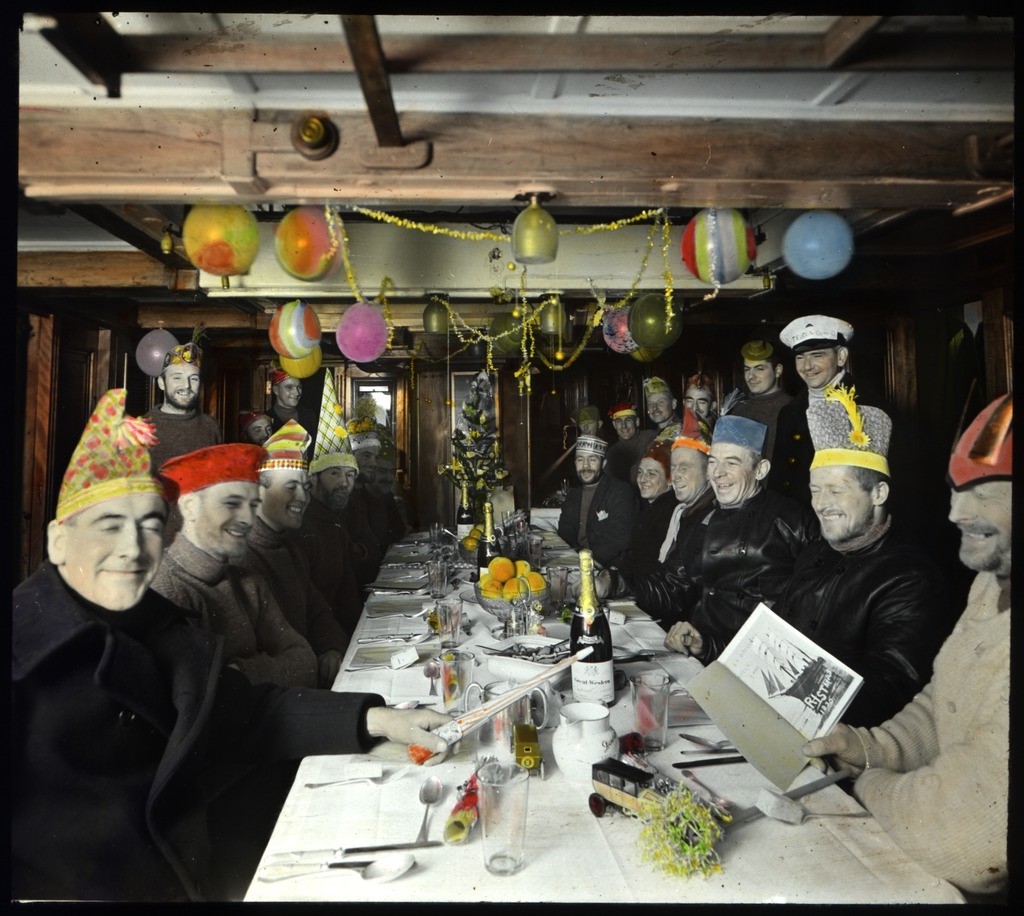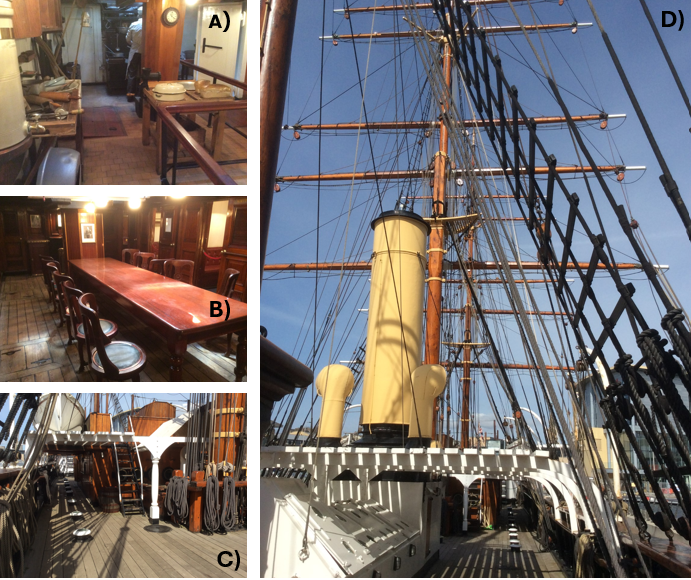This year, we thought it would be illuminating to portray a combination of Christmas celebration, hardship and poignancy but with a maritime flavour spanning the late-19th and mid-20th centuries, and volunteer Roger Burns has compiled a representative selection of events and stories.
Booze and mistletoe provide a good start! The Belfast Telegraph of 8 January 1872 relates: CHRISTMAS AT SEA. The steamship Cognac, most appropriate name, which arrived in Belfast yesterday morning from Cherente, and is present discharging a cargo of brandy, consisting of upwards of 1,200 cases, presents the novel spectacle of being decorated with evergreens. From the tops her fore main and masts are suspended neat branches of mistletoe commemoration of the Christmas time. The Cognac, ON29159, was a small 2-cylinder, iron hulled steamer, built at Liverpool in 1860 and which was lost in 1898 from a collision off Anglesey carrying brandy and general cargo.
When SV Sirenia was wrecked on the IoW in March 1888, two crew were lost including 24 year old American Leonard Dozier whose mother sent a very touching letter to the local lifeboat committee. Her letter was received the following February, written just prior to Christmas, which includes reference to the headstone over my son’s grave, to mark his resting place, will not only be to his memory, but a monument to your Christian character as well, and will ever be remembered by us with feelings of the deepest gratitude. I cannot find language sufficient to express our sincere thanks to you for the interest you have taken in this whole matter, my friend; it continued We are upon the eve of what ought to be a “Merry Christmas” to all, but it will not be a joyous season to us this year, for we shall miss our dear boy too much to be happy, and our hearts are too sad to enjoy a family gathering; so, my two daughters and myself will remain quietly at home after our church services are over; but try not to forget others who look to us for a measure of their enjoyment of this holy season.
1885 saw the start of off-shore sand dredging to be used in the extensions of what is now HMNB Devonport. This led to the unplanned loss of a fishing village and loss of livelihood for the villagers, for which the dredging contractor in 1897 undertook to pay the fishermen £125 per annum while dredging continued together with a Christmas gratuity of £20, deemed to be compensation for interference with the fishing, not for loss of the village shoreline. Little return for the villager’s losses!
‘Christmas Ships’ take many forms, including land based creations and sea-going vessels. For many decades on land, ‘Christmas Ships’ were assemblies of actual model ships or an imaginative framework bedecked with decorations and on which presents were hung for children at parties.
One example reported in the East Essex Advertiser and Clacton News of 3 January 1903 read: THE CHRISTMAS SHIP was also brilliantly illuminated and made a most effective sight. The ship itself was a full rigged model of a brig, the Middlesex, of which, Mr Pocock, the engineer, and Mr Martin, the head gardener, were respectively the designers and shipwrights. It was a splendid piece of work, and it was loaded from stem to stern with toys and presents.
A quite different approach comes from Lake’s Falmouth Packet and Cornwall Advertiser, 7 February 1908: A NOVEL PULPIT – Those associated with the Seamen’s Bethel and Institute may proudly boast of possessing one of the most novel pulpits in the country. The Christmas Ship, which became so popular with the sailors, has, at their wish, been rebuilt and made into a pulpit. The bow of the ship, which is rigged as a four-and-aft schooner, has everything complete, anchors, bell, steering wheel, and in fact everything necessary for a floating ship. The desk, which was made by the energetic chaplain, is made of iron, covered with velvet. The ship is strengthened by four stays made from a portion of a steamer wrecked on the coast some years ago.
Sea-going ships were often designated a ‘Christmas Ship’ assigned to a particular port, all over the world. Examples include the Allan Liner Virginia in 1905, Canada to Liverpool, bearing a record cargo of Christmas mail, with 5,000 Canadian turkeys and 3,000 barrels of apples for the London Christmas market – Bournemouth Daily Echo, 2 December1905; Cunard’s Lusitania, New York to Liverpool in 1908, and quoted in the Manchester Courier, 18 December 1908, Her Mail is the largest ever carried on any vessel consisting of no fewer than four thousand, nine hundred and thirty sacks of mail; In 1912, the Redesmere was designated as the ‘Christmas Ship’ to Manchester; and the Sphere, 3 February 1914, reported Christmas at Sea. By permission of the Admiralty two destroyers made a Christmas tour of the lightships around the Nore to distribute the gifts provided by the Missions to Seamen. The report mentioned that the turkey for the Christmas dinner on hoard the Barrow Deep Lightship was handed over to the seamen from the destroyer, Santa Claus.
SV John Lockett, registered at Liverpool, almost ran out of provisions for the crew at Christmas 1907 but reached Bahia on Christmas Eve. Its voyage of two years absence from UK shores was dogged by a plethora of misfortunes as highlighted in the Viewer.
Hardship examples include the loss of HMS Formidable on New Years Day, 1915, and HMT Abelard wrecked off Plymouth on Christmas Eve 1916. The general cargo steamship Penshurst, built at Montrose in 1906, was hired by the Admiralty in November 1915 during the First World War and sailed as HMS or HMAV Manford or Q7 as a decoy or Q-ship, with armament of 1-12pdr and 2-6pdrs. It accounted for German submarine UB-19 on 30 November 1916 and UB-37 on 14 January 1917 but Penshurst itself suffered. On 14 January 1917 it was damaged by shellfire from UB-37, again by gunnery from UB-32 on 30 March 1917, damaged by a torpedo from UC-72 on 19 August 1917 and was itself torpedoed on Christmas Eve 1917 by U-110, sinking several hours later in the Bristol Channel. There were two casualties, a 23 year-old stoker commemorated at the Chatham Naval Memorial and an 18 year-old cook commemorated at Plymouth Naval Memorial.
Designated ‘Christmas Ships’ continued after the First World War through to the Second World War. The Hartlepool Northern Daily Mail of 16 December 1939 headlined an article THE PLUM PUDDING SHIP and reported that the first Christmas Ship carrying plum pudding and greetings to the troops in France has sailed from an English port. Two hundred tons of Christmas parcels and 500,000 Christmas letters have left England in 24 hours.
The first half of the 20th century saw research expeditions of Antarctica, an example being the “Banzare” expeditions of 1929 to 1931 with the Dundee built Discovery. Christmas 1930 was spent aboard, Figure 1, and Figures 2.a to 2.d illustrate the restored ship, now open to visitors with an adjacent dockside exhibition hall.

Figure 1: Christmas onboard Discovery, 1930
Source: National Library of Australia Commons, No restrictions, via Wikimedia Commons

Figure 2.A: The Galley, 2.B: The Wardroom, 2.C: The deck showing some of the extensive rigging blocks, 2.D: Looking along the deck with part rigging. All images illustrate parts of the restored ship.
Source: Roger Burns for the Maritime Archaeology Trust
A tragedy with 819 casualties occurred on Christmas Eve 1944 when the SS Léopoldville was sunk near Cherbourg, and due to a mixture of circumstances aided by Christmas festivities in Cherbourg, it was deemed sufficient to keep the story censored for some 50 years.
Southampton, designated as the 14th Port, with significant American involvement, was heavily involved in the 1944 Normandy landings from June onwards. Welcome relief to the rigours of war came that Christmas when enlisted personnel from the port, with US Navy assistance, provided a party on the 23rd for 1,000 children at Southampton’s Guildhall. In the port itself, the American Postal Unit dealt with Christmas mail numbering 84,969 pouches of which 58,109 were parcel post bags.
Finally, staff at the Maritime Archaeology Trust and at the Shipwreck Centre and Maritime Museum wish all volunteers and readers a Happy and celebratory Christmas with best wishes for 2024.
